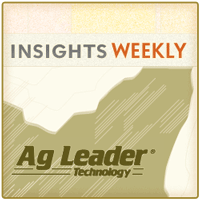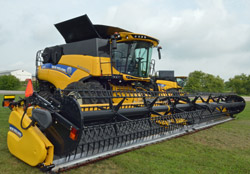 Many booths at the recent InfoAg Conference sported this little sign: AgGateway – SPADE Participant.
Many booths at the recent InfoAg Conference sported this little sign: AgGateway – SPADE Participant.
 We caught up with AgGateway Standards Director Jim Wilson at the John Deere booth to learn more about the SPADE project. “SPADE stands for Standardized Precision Ag Data Exchange,” Wilson explained. As a non-profit industry consortium, AgGateway is facilitating the project which will ultimately benefit growers by better integration of farm equipment with farm management information systems. “It’s about bringing, at this point, over 30 companies together to talk about their field operations processes, the data that flows to support those processes, what the data requirements are per message, and how those requirements map to existing standards or where we might need to create new standards.”
We caught up with AgGateway Standards Director Jim Wilson at the John Deere booth to learn more about the SPADE project. “SPADE stands for Standardized Precision Ag Data Exchange,” Wilson explained. As a non-profit industry consortium, AgGateway is facilitating the project which will ultimately benefit growers by better integration of farm equipment with farm management information systems. “It’s about bringing, at this point, over 30 companies together to talk about their field operations processes, the data that flows to support those processes, what the data requirements are per message, and how those requirements map to existing standards or where we might need to create new standards.”
Among the SPADE project members are John Deere, Ag Leader and MapShots. Learn more about the project on the AgGateway website and in this interview with Jim: [wpaudio url=”http://www.zimmcomm.biz/infoag/infoag-14-deere-aggateway-wilson.mp3″ text=”Interview with Jim Wilson, AgGateway”]




 It wasn’t long ago the focus was on getting the crops planted, fertilized, and sprayed. Hopefully the hard work is paying off and yields are looking good for the fall. With cost of inputs remaining high and a dip in most crop prices, it is very crucial to know what practices were successful and which did not have a good return on investment. Most growers that have diverse operations are curious on where the best yields are so they can know which seed, chemicals, and fertilizers worked best for their operation. By having the Ag Leader yield monitoring systems calibrated and ready for fall, growers will be able to know which practices made the most money.
It wasn’t long ago the focus was on getting the crops planted, fertilized, and sprayed. Hopefully the hard work is paying off and yields are looking good for the fall. With cost of inputs remaining high and a dip in most crop prices, it is very crucial to know what practices were successful and which did not have a good return on investment. Most growers that have diverse operations are curious on where the best yields are so they can know which seed, chemicals, and fertilizers worked best for their operation. By having the Ag Leader yield monitoring systems calibrated and ready for fall, growers will be able to know which practices made the most money.








